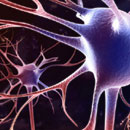|
Source: NORML & NORML Foundation 筋萎縮性側索硬化症 (ALS) は、別名ルーゲーリック病としても知られる致死性の神経変性障害で、脊髄や脳幹や運動皮質にある運動神経細胞が選択的に減少する特徴を持っている。アメリカでは3万人がALSとともに生きていると推計されている。しばしば、健康な成人が自然発生的にこの病気に被患し、半数以上の患者が発症から2年半以内に死亡する。 科学文献を検索してみると、ALSの治療にカナビノイドを使った臨床研究までは見つからないが、最近の臨床前研究ではカナビノイドにより症状の進行が遅くなることが示されている。患者たちからは以前より、カナビノイドが病気の進展を抑え、ALSにともなう痛みや食欲不振、うつ、よだれといった症状を和らげてくれるという証言が語られているが、それを補強するものになっている[1]。 筋萎縮性側索硬化症&運動ニューロン疾患ジャーナルの2004年3月号では、サンフランシスコにあるカリフォルニア太平洋医学センターの研究テームが、動物実験で、病気の発症前と発症後の両方でTHCを投与したところ、投与しない対照群に比較して症状の進行を食い止められて生存期間が伸びた、と報告している[2]。 ALSの動物モデルを使ったその後の実験では、THC以外の天然および合成カナビノイドでも進行が抑制されたが、必ずしも生存が長くなるわけでもないことも示されている[3-4]。最近の研究では、カナビノイド・レセプターCB1を塞いでブロックすると、ALSマウス・モデルで生存期間が伸びることが示され、このことから、ALSに対するカナビノイド効果がCB1レセプターに関係のないメカニズムからもたらされているのではないかとも考えられている[5]。 別の臨床前研究でも、生体外[6]および動物実験[7] で、カナビノイドには、フリーラジカルによる酸化に対抗する神経防護作用のあることが示されている。ALSでは脊髄にグルタミン酸塩が過剰に生成される特徴が知られているが、カナビノイドの神経防護作用は過剰生成を抑制する役割を果している可能性もある[8]。少なくとも、THCについては、培養したマウスの脊髄ニューロンの興奮毒性を抑えることが示されている[9]。 こうした結果から、現在では一部の専門家たちは、「カナビスには、筋萎縮性側索硬化症を薬理学的に調整する働き」[10] があり、「カナビスや合成カナビノイド・レセプター・アゴニストの有用性に関するさらなる研究には十分な可能性が見込める」[11] と考えている。 |






[1] Amtmann et al. 2004. Survey of cannabis use in patients with amyotrophic lateral sclerosis. The American Journal of Hospice and Palliative Care 21: 95-104.
[2] Raman et al. 2004. Amyotrophic lateral sclerosis: delayed disease progression in mice by treatment with a cannabinoid. Amyotrophic Lateral Sclerosis & Other Motor Neuron Disorders 5: 33-39.
[3] Weydt et al. 2005. Cannabinol delays symptom onset in SOD1 transgenic mice without affecting survival. Amyotrophic Lateral Sclerosis & Other Motor Neuron Disorders 6: 182-184.
[4] Bilsland et al. 2006. Increasing cannabinoid levels by pharmacological and genetic manipulation delay disease progression in SOD1 mice. The FASEB Journal 20: 1003-1005.
[5] Ibid.
[6] Raman et al. 2004. op.cit.
[7] Hampson et al. 1998. Cannabidiol and delta-9-tetrahydrocannabinol are neuroprotective antioxidants. Proceedings of the National Academy of Sciences 95: 8268-8273.
[8] Carter and Weydt. 2002. Cannabis: Old medicine with new promise for neurological disorders. Current Opinion in Investigational Drugs 3: 437-440.
[9] Abood et al. 2001. Activation of the CB1 cannabinoid receptor protects cultured mouse spinal neurons against excitotoxicity. Neuroscience Letters 309: 197-201.
[10] Carter and Rosen. 2001. Marijuana in the management of amyotrophic lateral sclerosis. The American Journal of Hospice and Palliative Care 18: 264-70.
[11] Carter et al. 2003. Drug therapy for amyotrophic lateral sclerosis: Where are we now? The Investigational Drugs Journal 6: 147-153.